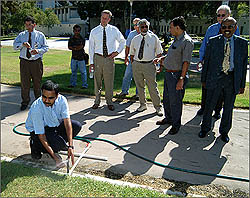| 
Engineer Designs Sprinkler Nozzle
That Avoids Water Runoff and Waste
October 21, 2004 :: No. 66
 |
Campus officials watch as Prasada
Rao, assistant professor of civil and environmental engineering,
makes an adjustment during a demonstration of a new sprinkler
nozzle he created. The nozzle, which fits in standard sprinklers,
can be adjusted to spray from 4 to 12 feet and can spray, at
varying distances, in up to six different directions. A patent
is pending on the nozzle. |
California, despite its lush parks, grasslands
and front yards, is a desert, which makes water nearly as precious
to the state as gasoline.
That’s why a Cal State Fullerton assistant professor
of civil and environmental engineering has designed a specialized
sprinkler that will keep the desert looking green without wasting
a limited natural resource.
With the support of a $33,000 U.S. Department of the
Interior grant, Prasada Rao has designed a sprinkler nozzle that
can be adjusted to spray water in as small an arc as 4 feet or as
large as 12 feet — and any length in between. Further, his
design allows a single sprinkler to water in up to six directions
and six different lengths to cover that pear-shaped lawn, oval planter
or grass along a winding walkway.
His creation has generated interest from both industry
and government officials. A patent on the sprinkler head is pending.
This Friday, Oct. 22, Rao will serve as a panelist
on “Technology and Inventions” at the Southern California
World Water Forum sponsored by the Metropolitan Water District.
Last month, Rao and Meena Westford of the U.S. Bureau of Reclamation
teamed for a joint presentation about the new nozzle to the California
Urban Water Conservation Council in Santa Barbara.
“Existing sprinkler nozzles perform well for
landscape areas that are laid out in square or rectangular patterns,”
said Rao. “Where there are curved driveways, the sprinkler
will spray water on non-lawn areas and contribute to water waste.”
The engineer noted that according to a U.S. Geological
Survey, of the 26 billion gallons of water consumed daily in the
United States, approximately 30 percent, or 7.8 billion gallons,
are used outdoors— a significant portion of that on landscaping.
And in arid regions, like California and other states in the southwestern
United States, the amount of water consumed daily for watering plants,
lawns and gardens can be as high as 60 to 90 percent.
Therefore, Rao noted, it is vital to ensure that water
is being used for its intended purpose and not flowing down city
streets to drains that carry the water — as well as trash
and other pollutants picked up along the way — to the ocean.
“In Orange County last year, we saw portions
of our beaches closed to public use or advisories issued for an
accumulated total of 1,329 days for all county beaches because of
polluted water. In Los Angeles County, it was 1,459 days,”
Rao added.
“With a growing population and dwindling water
sources, the advantages of using the proposed sprinkler nozzle are
manifold. An improved sprinkler system can open new windows for
improved landscape design. Since urban lifestyle and good landscaping
go hand in hand, an offshoot of this work is an enhanced quality
of life. With rising water costs and depleting water sources, the
proposed sprinkler can benefit both the user and water management
agencies.”
Rao noted that the Department of the Interior and
other water agencies are focusing on developing new technological
tools to aid in conservation. “We are hoping this sprinkler
nozzle will revolutionize landscaping in the years to come,”
he added. “There is nothing on the market now that will do
this job.”
The device is similar to the pop-up sprinkler nozzles
currently found in hardware and home-improvement stores across the
country, noted Rao. The nozzle can replace current sprinkler nozzles
used by residential users, and also be deployed by city, county
and state agencies for parks and other municipal uses.
Earlier this year, a federal omnibus appropriations
bill earmarked $100,000 to further Rao’s research in developing
sensors to identify substances placed in the water supply that could
harm drinking water. Rao, who earned his doctorate at the Indian
Institute of Technology, has been a member of the Cal State Fullerton
faculty since 2002.
| Media Contacts: |
Prasada Rao, assistant professor
of civil and environmental engineering, at 657-278-3525 or
mprasadarao@fullerton.edu
Pamela McLaren of Public Affairs, at 657-278-4852 or pmclaren@fullerton.edu |
«
back to University News
|